 KEY TAKEAWAYS:
KEY TAKEAWAYS:- Method 1: Hevo Data Automated Migration
- Offers a fully automated, no-code data pipeline solution capable of handling large-scale, continuous, and near real-time syncing of PostgreSQL data to Google Sheets.
- Method 2: Coefficient
- No-code, GUI-based tool ideal for quick, user-friendly setups to import live data from PostgreSQL to Google Sheets with minimal technical knowledge required.
- Method 3: Google Apps Script
- Provides full customization and control, letting users automate advanced integrations and workflows between PostgreSQL and Google Sheets using JavaScript.
- Method 4: Zapier
- Provides a simple, visual workflow automation for event-driven syncing between PostgreSQL and Google Sheets, suitable for lightweight sync scenarios and multi-step actions that save time for business users.
- Method 5: CSV Upload
- Easiest manual method, requiring no special tools or coding—just export data from Google Sheets as CSV and import into PostgreSQL (or vice versa).
Managing data efficiently often means bridging the gap between powerful databases and user-friendly tools. PostgreSQL, a robust open-source database, and Google Sheets, a versatile spreadsheet platform, are a perfect pair for this—whether you’re analyzing data, sharing insights, or automating workflows.
In this blog, we’ll explore five practical methods to connect Postgres to Google Sheets: using Hevo method for a fully automated solution, Coefficient for a seamless solution, leveraging Google Apps Script for custom automation, tapping into Zapier for quick integrations, and employing the straightforward CSV upload method for manual transfers. Each approach has its strengths, and we’ll break them down to help you choose the best fit for your needs. Let’s dive in!
Table of Contents
Methods to migrate data from Postgres to Google Sheets
Let’s discuss a few methods by which we can integrate Postgres to Google Sheets.
Method 1: Connect PostgreSQL to Google Sheets with Hevo
Step 1: Create a New Pipeline
- From the dashboard, click on “Create Pipeline” to start a new data pipeline.
Step 2: Configure PostgreSQL as Source
- Select PostgreSQL from the list of source connectors.
- Enter PostgreSQL connection details:
- Database Host (server address)
- Port (default is usually 5432)
- Database Name
- Username
- Password
- Test the connection to ensure Hevo can access your PostgreSQL database.
- Choose the schema and tables you want to replicate or sync.
Step 3: Configure Google Sheets as Destination
- Select Google Sheets as your destination connector.
- Authenticate with your Google account and authorize Hevo to access your Google Sheets.
- Select or create the specific Google Sheet or Spreadsheet where you want to load your PostgreSQL data.
- Map the fields from your PostgreSQL tables to the Google Sheets columns if needed.
Step 4: Set Up Data Transformation (Optional)
- Use Hevo’s transformation features if you want to clean, enrich, or modify data before it reaches Google Sheets.
Step 5: Choose Ingestion Mode
- Select the ingestion mode (e.g., real-time streaming, batch sync) based on your data update frequency needs.
Step 6: Start the Pipeline
- Activate the pipeline and let Hevo automatically extract, transform, and load data from PostgreSQL to Google Sheets.
- Monitor the pipeline status and logs for successful data transfer.
Step 7: Access Data in Google Sheets
- Open your connected Google Sheet to view the synced PostgreSQL data in near real-time or scheduled batches as configured.
Migrate Data Seamlessly Within Minutes!
Method 2: Using Coefficient
It is a tool to import live data into spreadsheets automatically. Some of its features include :
- Quick Integration: Import your data in seconds.
- Live Analytics: Unlock Live Data and Dashboards for your team.
- Auto Update: Updates systems directly from your spreadsheets.
Steps to install and use Coefficient for data migration
- Select Extensions → Add Ons → Get Add Ons.
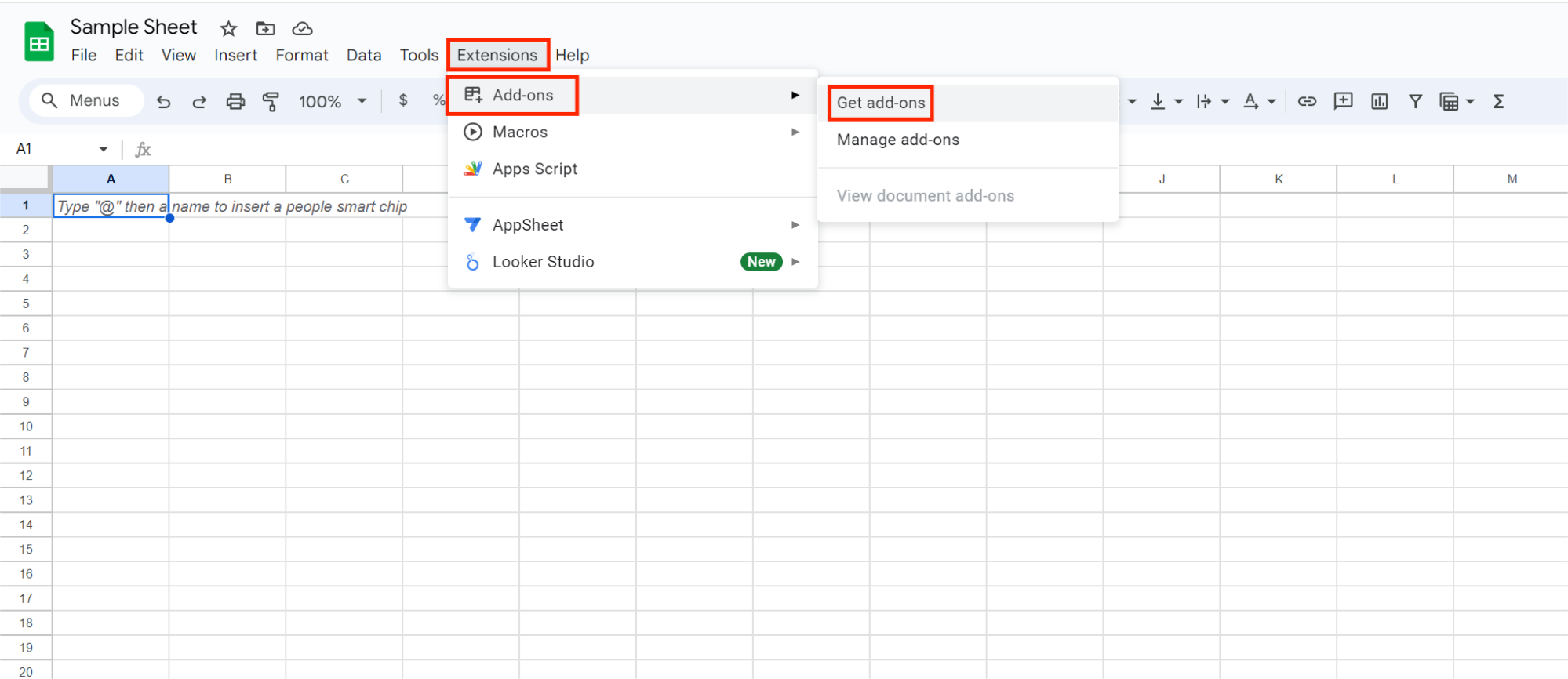
- Search for Coefficient in Google Workspace Marketplace and install it.
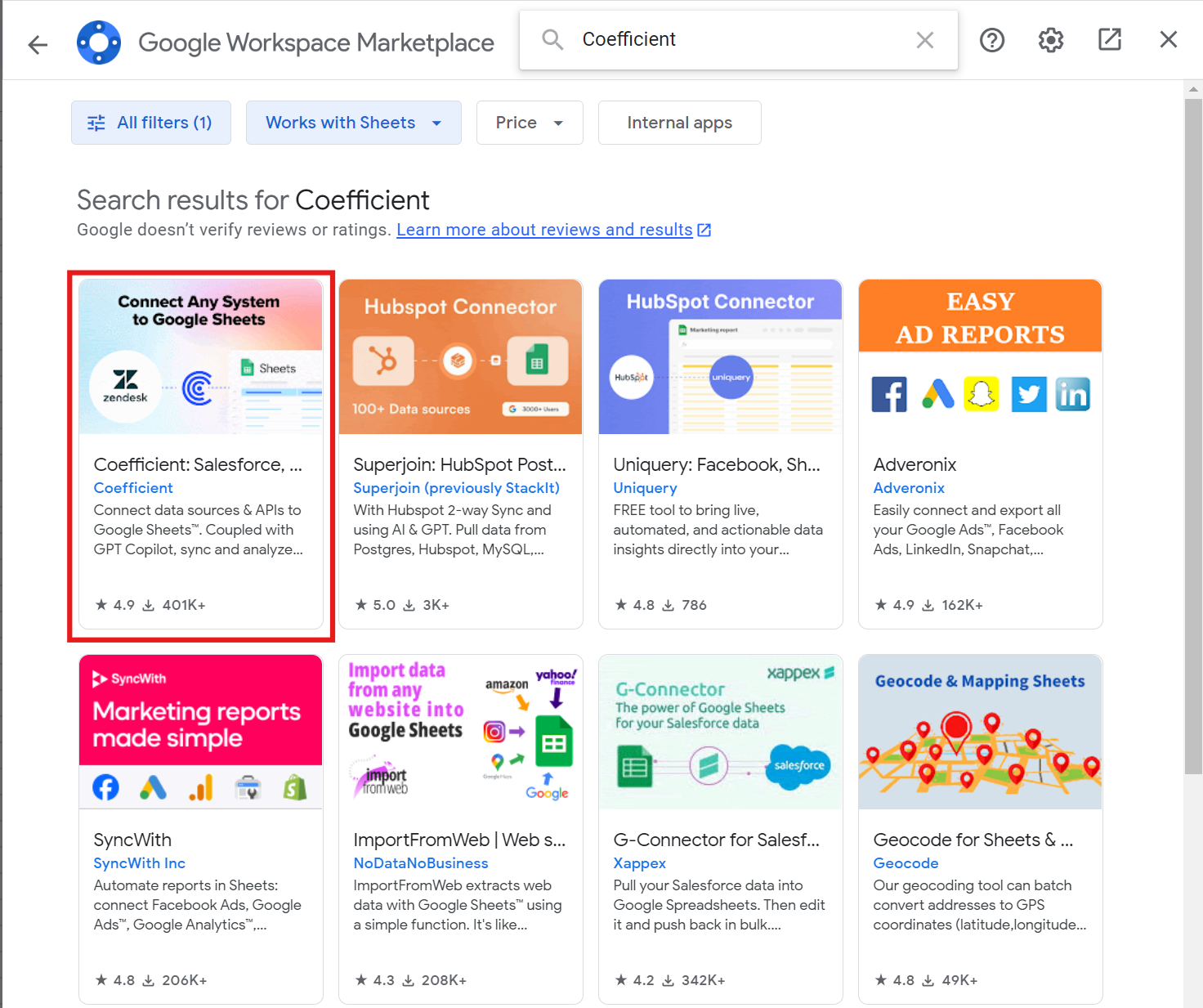
- After installation, Select Extensions → Coefficient → Launch.
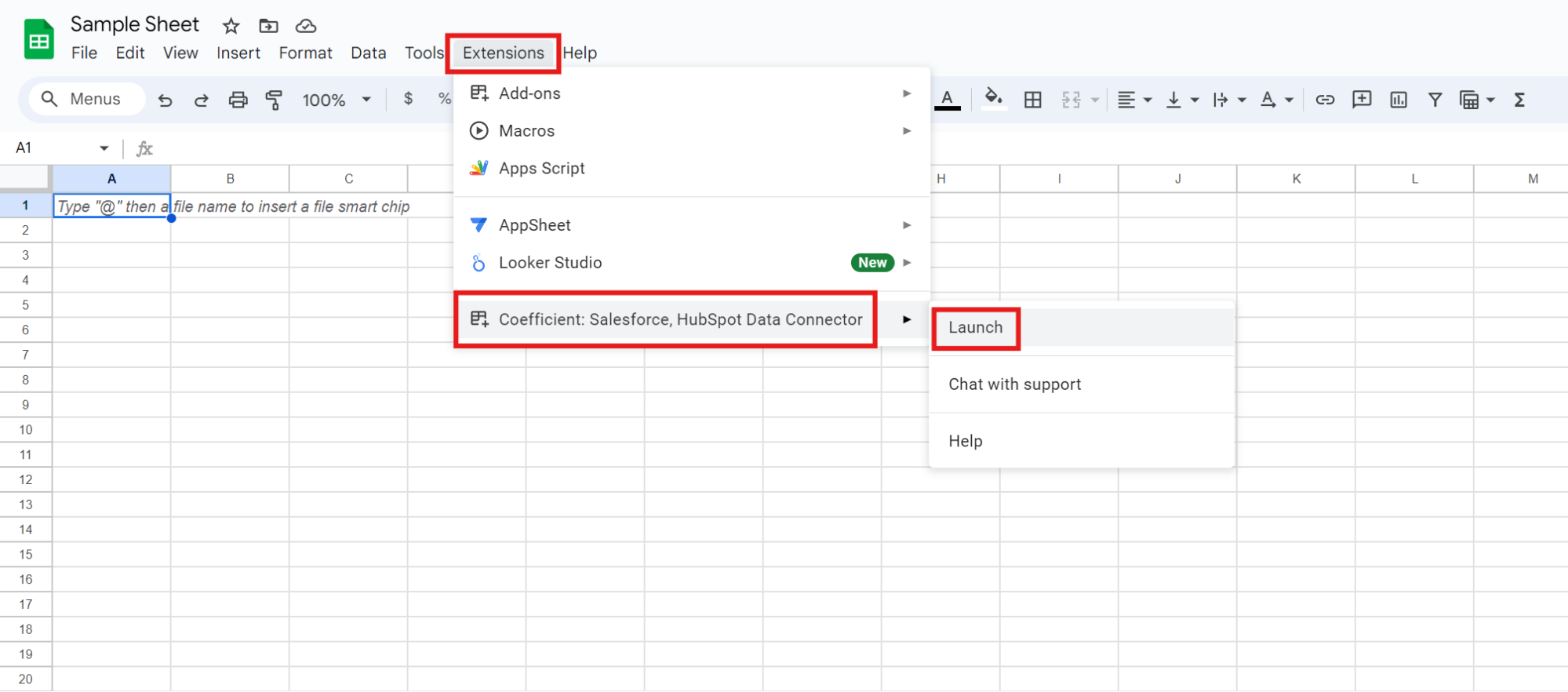
- Fill out your details. Select Import from the Coefficient Panel on your screen’s right side.
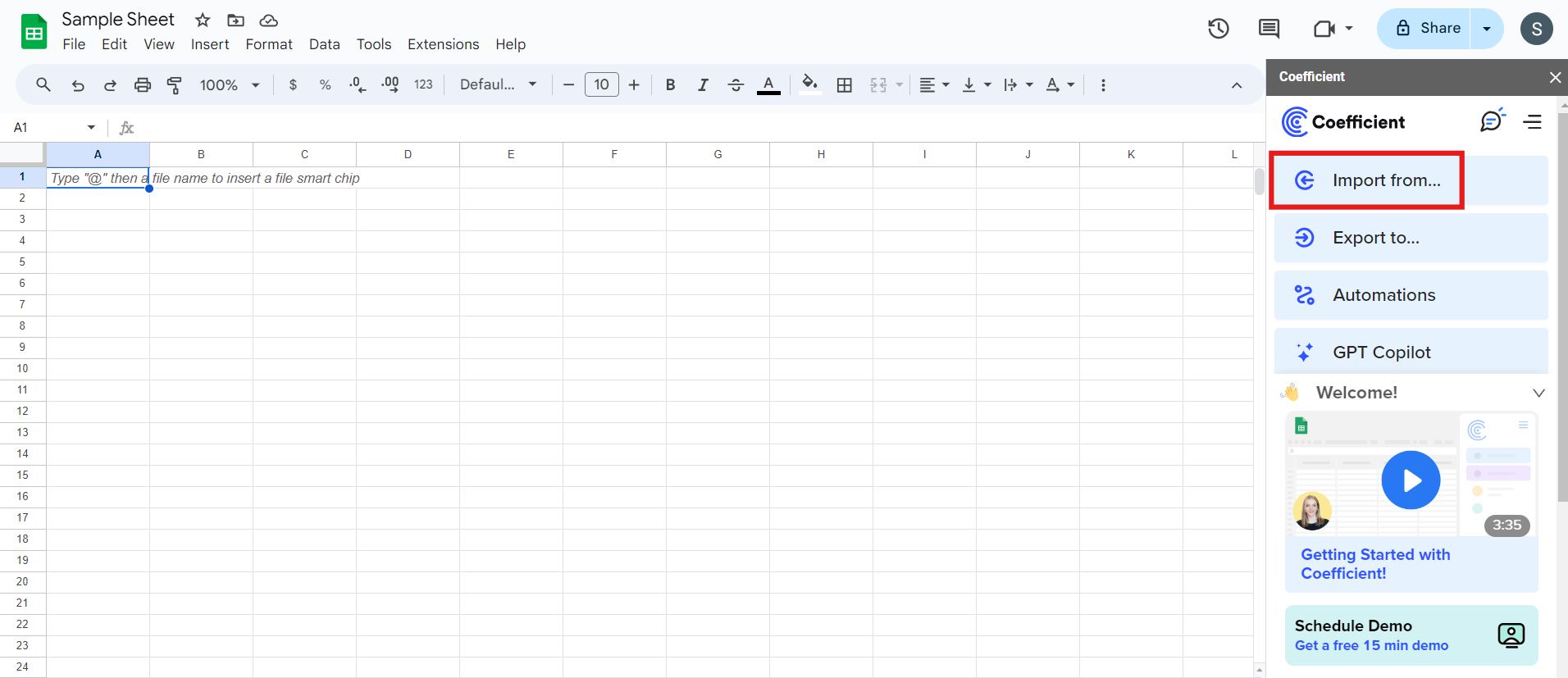
- Click PostgreSQL from the list of Data Sources provided and enter your host and database name. Also, if you scroll down, fill out the username and password fields.
Note: The Port field will be filled out by default to 5432; do not change it.
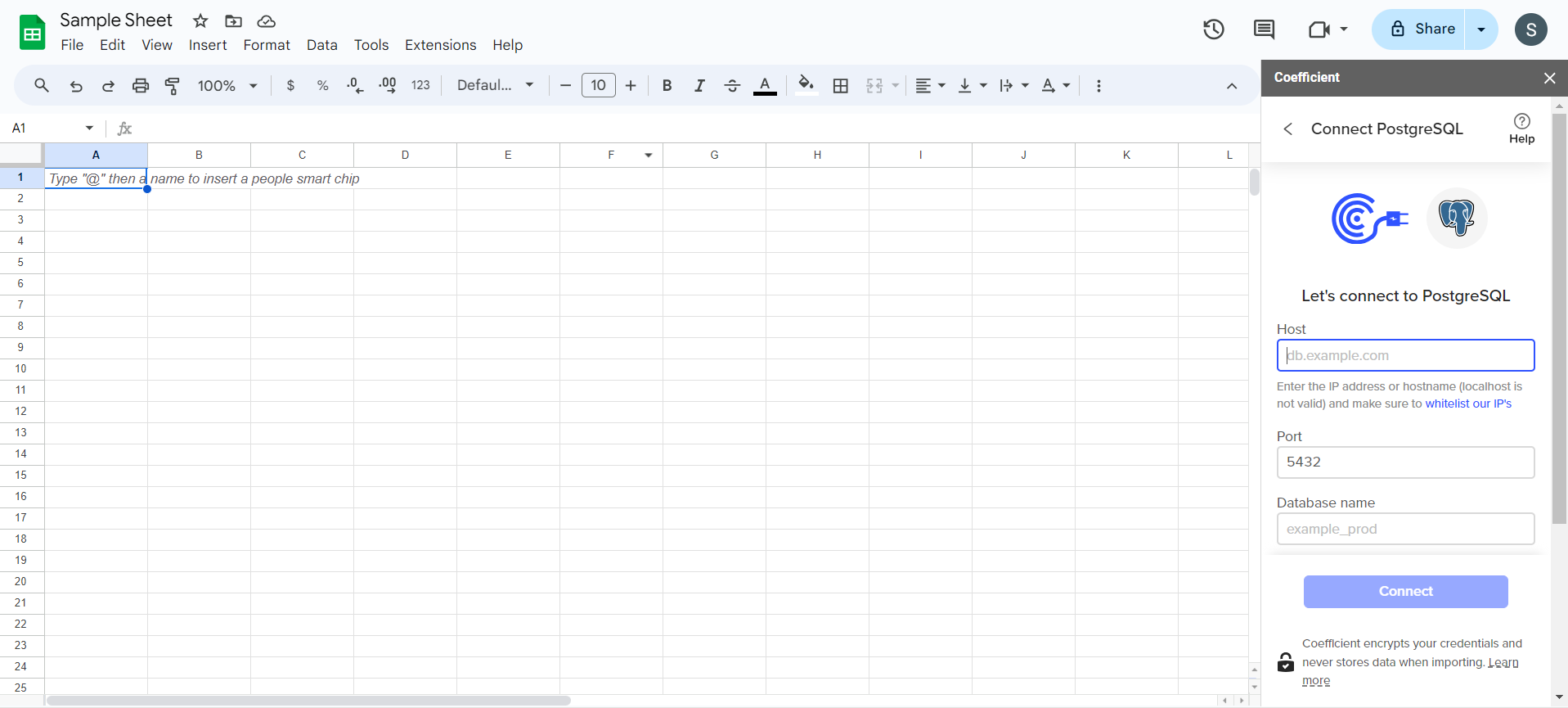
- Select the Data you want to import and Click on Export. The data will be auto-populated from Postgres to Google Sheets, as shown in the screenshot below.
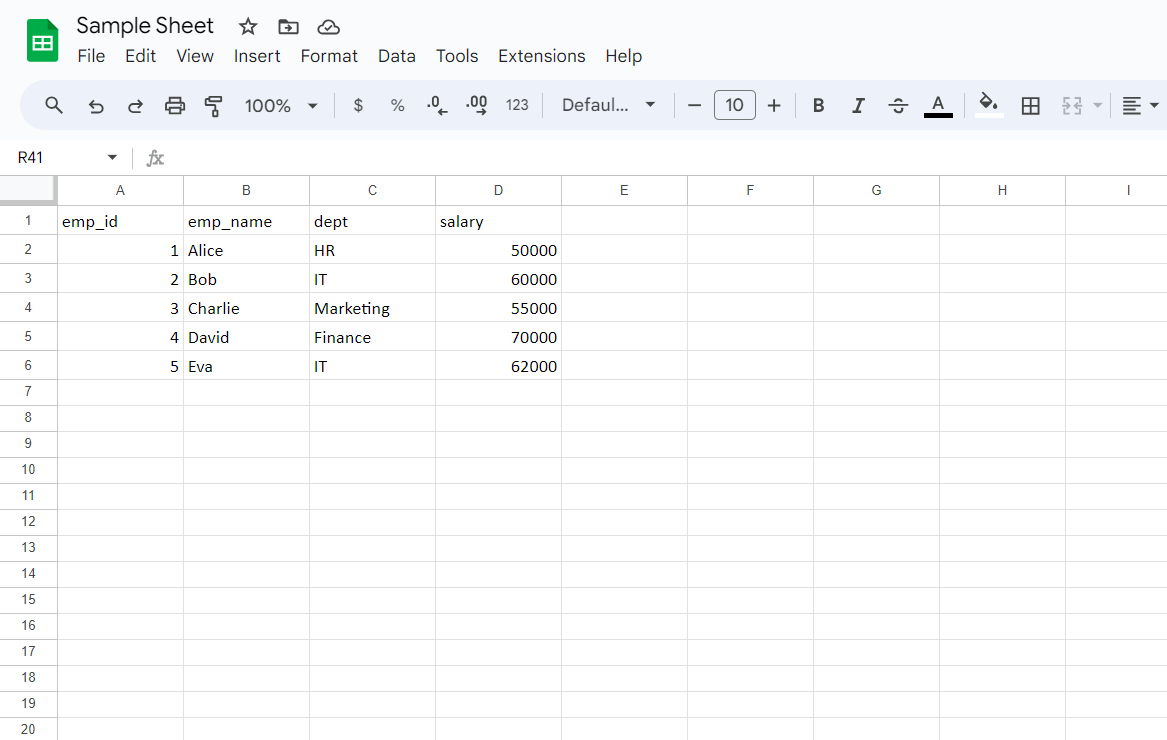
Limitations
- Limited Support to Databases: It does not support specific versions of databases.
- Performance Consideration: Depending upon the volume of your data to be migrated, its performance may vary.
Method 3: Google Apps Script
Google Apps Script is a scripting platform developed by Google for lightweight application development on the Google Workspace platform.
- Seamlessly integration: Apps Script with Google Workspace apps allows you to automate processes in Google Sheets, Docs, Slides, Forms, and Gmail.
- Built-in script editor: It offers an online integrated development environment (IDE), allowing you to write, modify, debug, and manage your scripts within your browser.
Steps to migrate data using Google App Script :
- Create a new Google Sheet and copy its URL. Go to Extensions → Apps Script.
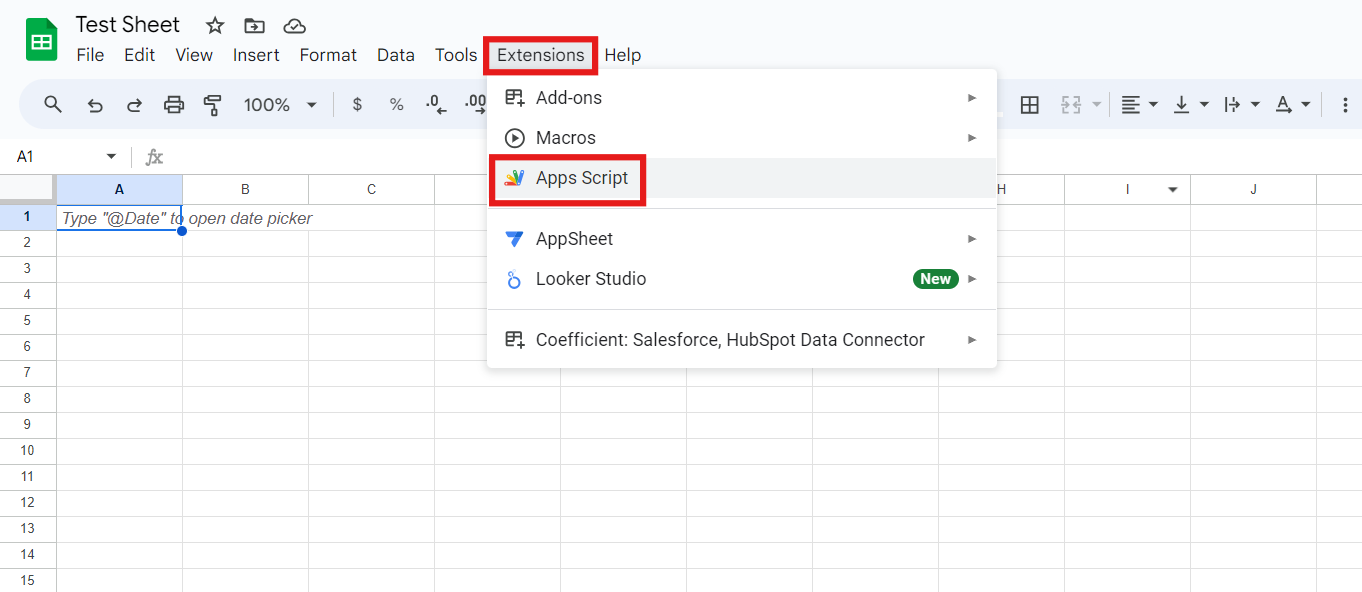
An Apps Script editor will open in a new tab.
- You can retrieve your data from PostgreSQL to Google sheet with a sample script below:
var dbUrl = 'jdbc:postgresql://<HOST>:<PORT>/<DATABASE>';
var user = '<USERNAME>';
var userPwd = '<PASSWORD>';
function importDataFromPostgres() {
// Connect to the PostgreSQL database
var conn = Jdbc.getConnection(dbUrl, user, userPwd);
// Perform a query
var stmt = conn.createStatement();
var results = stmt.executeQuery('SELECT * FROM your_table LIMIT 10'); // Modify your query as needed
// Get the active spreadsheet
var sheet = SpreadsheetApp.getActiveSpreadsheet().getActiveSheet();
// Clear any existing content
sheet.clear();
// Get the number of columns in the result set
var numCols = results.getMetaData().getColumnCount();
// Write column headers
var headers = [];
for (var col = 1; col <= numCols; col++) {
headers.push(results.getMetaData().getColumnName(col));
}
sheet.appendRow(headers);
// Write data rows
while (results.next()) {
var row = [];
for (var col = 1; col <= numCols; col++) {
row.push(results.getString(col));
}
sheet.appendRow(row);
}
// Clean up
results.close();
stmt.close();
conn.close();
}Note: Replace the placeholder values in dbUrl, user, and userPwd with your actual PostgreSQL database host, port, database name, username, and password.
- To configure the JDBC Driver in your Google Apps Script. Go to Libraries, type the Script ID, and Click on Add, as shown in the below image:
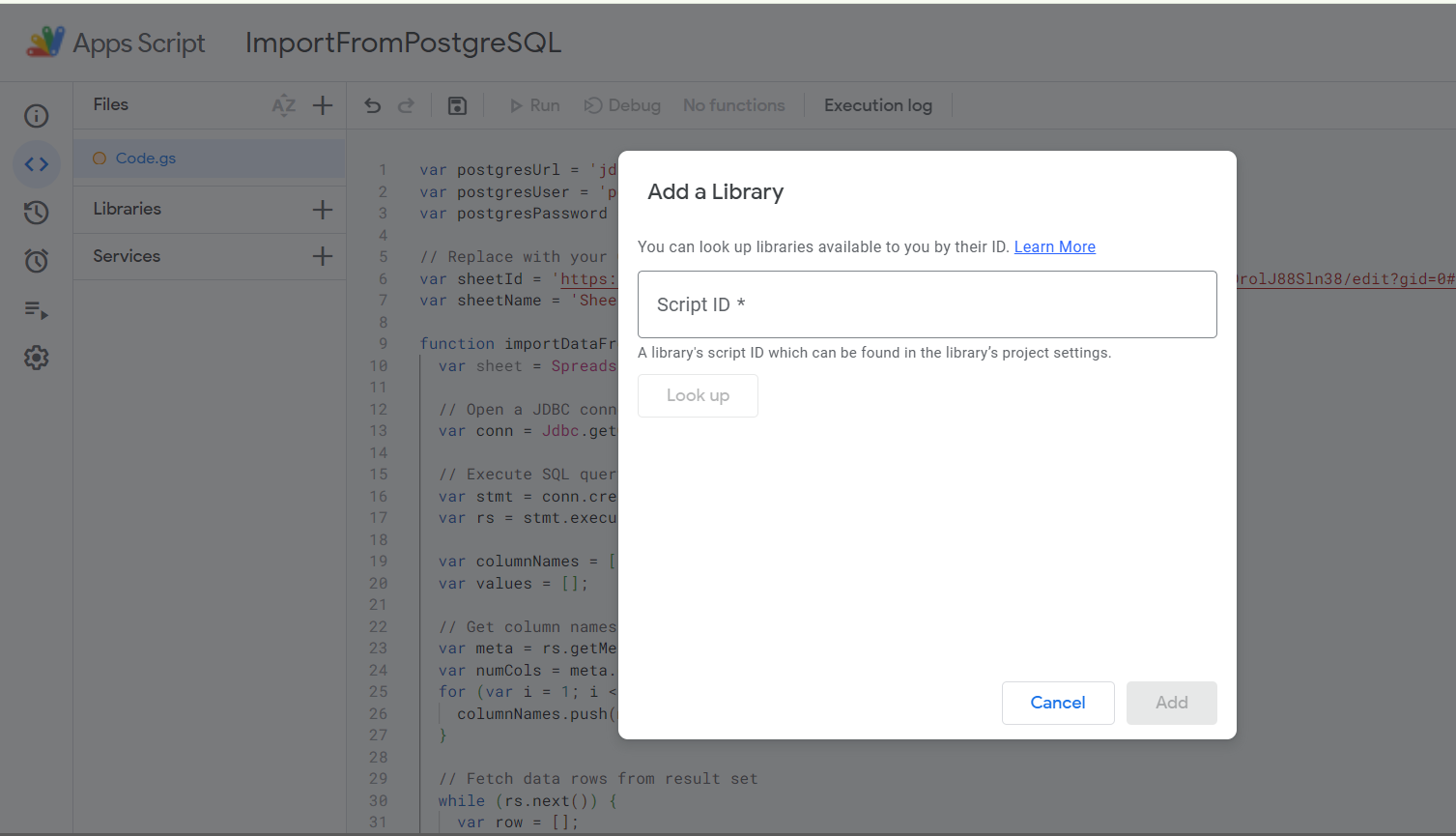
- Run the Migration Script. This script will connect to your database to fetch and insert data from Postgres to Google Sheets.
Limitations :
- Limited Programming Language Support: It mainly supports Javascript, which might need some of the features other languages provide.
- Integration Limitations: While it offers integrations with Google Workspace Apps, integrating external services or non-Google APIs may require more complex setups.
Method 4: Connect Postgres to Google Sheets using Zapier
Zapier lets you connect PostgreSQL with thousands of popular apps, automating your work and freeing up time for what matters most—no code required.
- Using a straightforward visual builder, users may develop automated workflows or “Zaps.” Zaps consist of actions (tasks carried out automatically) and triggers (events that initiate the automation).
- Zapier supports multi-step Zaps where multiple actions can be carried out together, allowing for complex automation sequences.
Steps to migrate data using Zapier :
- Log in to Zapier. Click on +Create → Zaps.
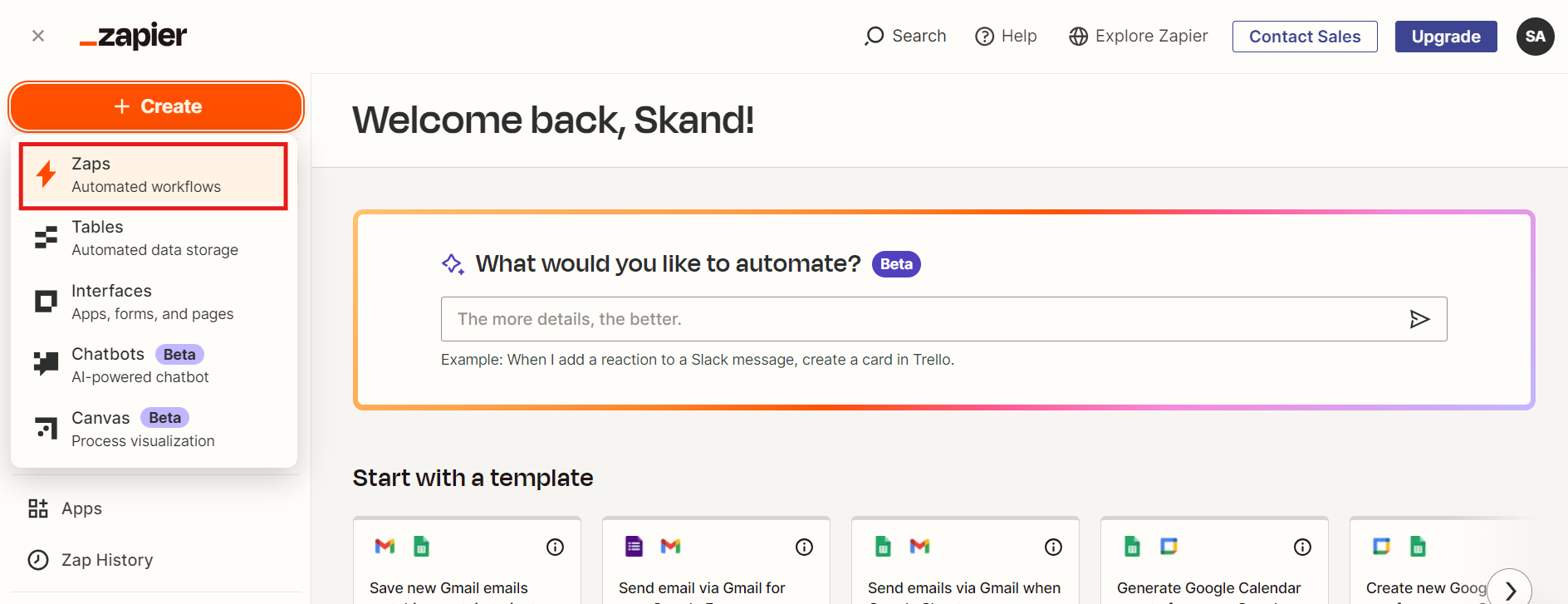
- You will be directed to a Zaps Editor Page. Click on Trigger to connect to the PostgreSQL as the source. Click on Action to connect to Google Sheets as the destination.
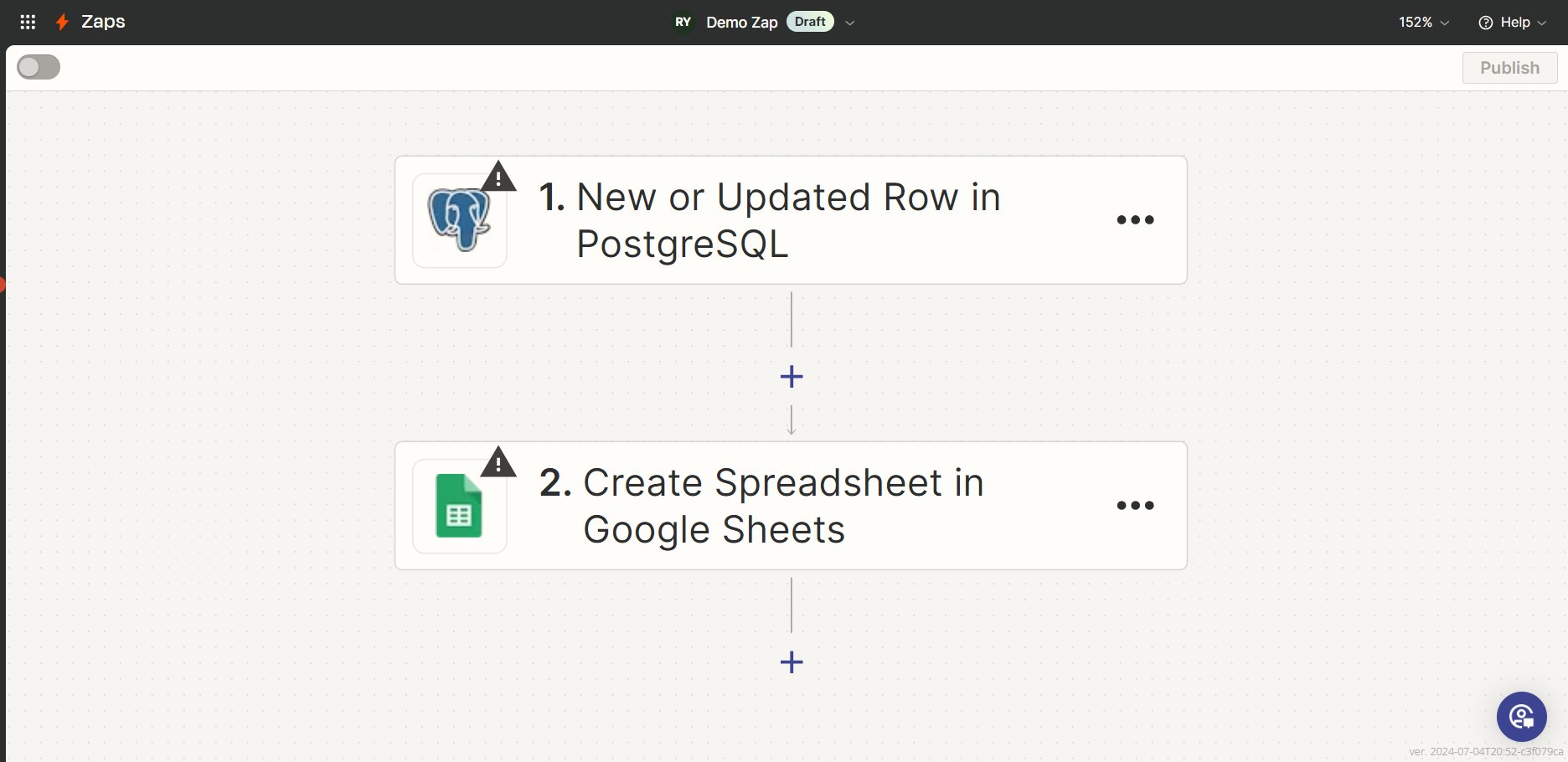
Note: If you are done with your configurations, Publish your Zap.
Limitations :
- Performance: Performance problems might arise from large-scale data migrations because of action triggers and large-scale dataset processing delays. It may impact the dependability and speed of data transfers.
- Limited Error Handling: Although Zapier offers error logs and alarms for unsuccessful activities, complex error handling and retry procedures could call for further tools or customized configurations.
Method 4: Using CSV Upload
Step 1: Export Data from Google Sheets as CSV
- Open your Google Sheet.
- Click File → Download → Comma-separated values (.csv, current sheet).
- Save the CSV file to your local system.
Step 2: Transfer the CSV File to the Database Server (if required)
- If your PostgreSQL database is on a remote server, you need to transfer the CSV file using SCP or any other method:
scp /path/to/your-file.csv user@your-server:/destination/path/Step 3: Prepare PostgreSQL for Import
- Log into PostgreSQL
<code>psql -U your_username -d your_database- Create a table matching the structure of your CSV file:
<code>CREATE TABLE your_table ( column1 TEXT, column2 INT, column3 DATE ); (Modify column names and types based on your dataset.)Step 4: Import CSV into PostgreSQL
- Using
COPYcommand (if running psql locally and have access to files on the database server):
<code>COPY your_table FROM '/path/to/your-file.csv' DELIMITER ',' CSV HEADER;- Using
\copy(if running psql from a client machine):
<code>\copy your_table FROM '/path/to/your-file.csv' DELIMITER ',' CSV HEADER;Step 5: Verify the Data Import
Run:
<code>SELECT * FROM your_table LIMIT 10;If the data looks correct, you’ve successfully connected Google Sheets to PostgreSQL via CSV upload!
Importance of Integrating Postgres to Google Sheets
- Streamlined Workflow: Integrating Postgres with Google Sheets streamlines workflows because sharing and updating data is easy.
- Real-time Data Reporting: You can generate real-time reports and dashboards directly by connecting Postgres to Google Sheets. This helps you respond quickly to changing customer demands.
- Automated Data Import: Integration can automate importing your data from Postgres to Google Sheets. This reduces human intervention, which ultimately minimizes errors.
Depending on your specific needs, such as budget constraints, technical expertise, and ease of maintenance, you can choose the best method for migrating data from Postgres to Google Sheets.
Want to take Hevo for a spin?
Conclusion
Today, we discussed different third-party tools like Coefficient and Hevo Data. With their intuitive UI and automated scheduling, third-party tools could be a good choice if you’re looking for a simple setup requiring little technical expertise.
You can use the rich customization and control that Google Apps Script offers when developing customized solutions that integrate Postgres to Google Sheets. Several variables, including the required level of automation, particular integration needs, and technological know-how, determine the optimal approach.
Sign up for a 14-day free trial to ease your data integration process.
FAQs
1. How do I convert Google Sheets to a database?
To convert Google Sheets data into a database, export the data in a structured format such as CSV or Excel. Then, choose a database where you want to import it, and finally, import the data using database management tools like MySQL Workbench and pgAdmin.
2. Can we use Google Sheets as a database?
Yes, Google Sheets can be used as a database in specific scenarios, particularly for small-scale applications or prototyping where simplicity and ease of use are prioritized over advanced database features.
3. Can Google Sheets query a database?
Google Sheets can query data from external databases using Google Sheets’ built-in functions and add-ons.




